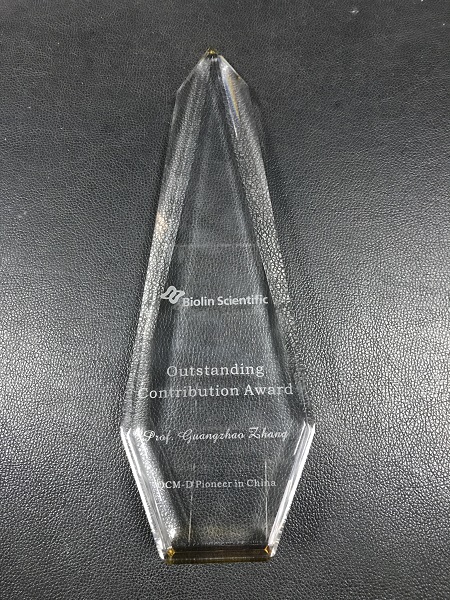Recently, Mattias Bengtsson, CEO of Biolin Scientific, Peter Simonsbacka, Chairman of the Board of Biolin, and Vanilla Chen, General Manager of Asia Region of Biolin, came to South China University of Technology to present the “Outstanding Contribution Award” of QCM-D technology to Professor Guangzhao Zhang for his contribution to the development and application of QCM-D.
Based on the traditional quartz crystal microbalance technology, the quartz crystal microbalance technology with dissipative function (QCM-D) is an emerging detection method developed by Bengt Kasemo et al. in the late 1990s. The technology of QCM-D is now owned by Biolin Scientific. It can detect the mass and structural changes of materials in physical and chemical changes on nanoscale, so as to reflect its interaction mechanism. In 2002, Professor Guangzhao Zhang purchased the first QCM-D equipment in mainland China when he worked at the University of Science and Technology of China. At that time, the use of QCM-D just began worldwide, and the significance of QCM-D parameters in the macromolecular system was still unclear. Professor Guangzhao Zhang took the lead in determining the physical significance of two parameters, frequency and dissipation factor, in macromolecular systems with QCM-D (Macromolecules 2014), i.e. the frequency change (Df) corresponds to the solvation of macromolecules, and the dissipation factor change (DD) corresponds to the conformational change of macromolecules. The relationship between these two parameters reflects the synergy between solvation and conformational change. Zhang’s work laid the foundation for QCM-D in the applications of polymer solutions and interface.
Professor Zhang then used QCM-D technology for polymer grafting, adsorption, degradation kinetics, protein adsorption and other areas. During his work at the South China University of Technology, he successfully developed biodegradable polymer-based antifouling marine materials with QCM-D as a basic characterization tool. Based on the large amount of data, he proposed the concept of “Dynamic Surface antifouling”, which is a breakthrough for marine antifouling. Due to the influence, guidance and promotion of Zhang and some other European and American scholars, QCM-D has been widely used in various fields such as materials, biomedicine, chemistry, environment, agriculture, electronics, and others. It has become a favorable characterization tool in modern scientific research.

Fig.1 Biolin Scientific presented the award to Professor Guangzhao Zhang

Fig.2 “Outstanding Contribution Award” of QCM-D technology





